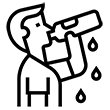Staying cool at work in the hot weather: top tips for nurses

Overheated workplaces and lack of access to drinking water can affect concentration and cause dehydration and even heat stroke. Find out how to cope in the heat
- Nurses often find themselves in uncomfortably hot working conditions due to unregulated heating systems, lack of fresh air and uncomfortable uniforms
- What regulations say employers must do to ensure acceptable temperatures and conditions at work, and how to raise the issue at your workplace
- Tips for staying hydrated on shift and staying alert for signs of heat exhaustion

During the summer months, it is likely there will be days when nurses are faced with working in uncomfortably hot conditions.
So, what can you do to keep cool as temperatures climb and work pressures stay as high as ever?
20 minutes
break is the minimum all UK workers are entitled to when working six hours or more
Source: Working Time Regulations 1998
Nurses forced to work in sweltering conditions
Nurses told Nursing Standard on social media that they often struggle with baking temperatures at work, with radiators and underfloor heating unable to be switched, off even in the summer.
Uniforms are often made from sweat-inducing and clingy fabric, which adds to the discomfort, many say.
Some nurses told Nursing Standard they were unable to wear scrubs, which they found cooler, while others preferred tunics and dresses.
‘Radiators aren’t individually controlled in individual rooms, so are on even when we are in a heatwave,’ one nurse commented on Twitter.
One nurse remarked that there were no windows in the small office where they train new surgical nursing staff. ‘No cool water anywhere,’ she said. ‘Office becomes an oven of stale air by the end of the day.’
Guidance and legislation on maintaining a comfortable temperature in the workplace
The Health and Safety Executive (HSE) says that employers have a responsibility to manage the ‘thermal comfort’ – the feeling of being at the right temperature – of their staff in the workplace.
It says employers should keep the temperature at a comfortable level and provide clean and fresh air. It also says employers should provide cooling options, for example fans, where a comfortable temperature cannot be maintained throughout each workroom. There should also be sufficient space in working areas.
Workplace temperature, and employee’s comfort in relation to it, is covered by the welfare aspect of the Workplace (Health, Safety and Welfare) Regulations 1992.
Unfortunately, the regulations stop short of specifying a minimum or maximum temperature. Instead, employers are legally obliged to maintain a ‘reasonable’ temperature during working hours.
What is more helpful, however, is the code of practice that accompanies these regulations. While not legally enforceable, the code recommends temperatures should be at least 16°C, or 13°C where staff are using considerable physical effort to do their jobs. In the case of warm temperatures, the code recommends local cooling (such as fans and opening windows) where a comfortable temperature cannot be maintained.
How employers can help take the heat off at work
- Provide fans

- Ensure windows can be opened
- Shade employees from direct sunlight with blinds or by using reflective film on windows to reduce the heating effects of the sun
- Site workstations away from direct sunlight or other situations or objects that radiate heat (such as equipment)
- Relax uniform code, while ensuring personal protective equipment is provided and used if required

- Allow sufficient breaks to enable employees to get cold drinks or cool down
- Provide additional facilities such as cold-water dispensers. Water is preferable to caffeine or carbonated drinks
- Introduce formal systems of work to limit exposure to heat, such as flexible working patterns, job rotation and workstation rotation
- Place insulating materials around hot pipes

- Provide air-cooling or air-conditioning plant
Source: Health and Safety Executive
Uncomfortable temperature for staff on wards
Heatwaves are becoming more common, government advice warns.
During a heatwave in 2018, the RCN said some nurses reported feeling exhausted, sick and dizzy as the hot weather sent temperatures on some wards soaring to more than 30ºC.
One nurse was admitted to an emergency department with dehydration after working three 12-hour shifts in a row during the heatwave, the college reported.
A study in the Netherlands suggests that nurses working on hospital wards prefer a cooler temperature to patients. Temperatures on wards included in the 2018 study ranged from 20-25 °C, which researchers concluded led to a ‘slightly unacceptable thermal comfort perception and compromised work performance’.
How perimenopause and menopause can affect nurses’ reaction to temperature
Uniforms becoming uncomfortable and clingy in hot weather is a particular issue during perimenopause and menopause, nurses have told Nursing Standard in recent years.
RCN guidance on the menopause at works says uniforms should not be made of nylon or be too close-fitting, to help staff cope with hot flushes and day sweats.
37.8°C
was the temperature reached on the UK’s hottest day of 2020, recorded at Heathrow Airport on 31 July
Source: Met Office
RCN head of health, safety and well-being Leona Cameron says employers have a responsibility to look after their staff and protect them from hot temperatures.
‘If the workplace is unreasonably hot, your employer should carry out a suitable and sufficient risk assessment to identify adequate control measures to prevent heat stress from occurring, so far as is reasonably practicable,’ she says.
‘Factors to consider could include the type of work being undertaken, the work environment, the clothing being worn and the wearing of respiratory protective equipment, as well as individual medical factors.’
Symptoms of heat stress and heat stroke
Sufficient hydration is critical to avoid heat stress, symptoms of which include an inability to concentrate, muscle cramps, heat rash, severe thirst and fainting, Ms Cameron says. This can cause heat exhaustion – with symptoms including fatigue, nausea and headache – and, in severe cases, heat stroke.
Heat stroke is a medical emergency that should prompt a 999 response, according to the NHS.
Signs of heat stroke include feeling unwell after 30 minutes resting in a cool place and drinking of plenty of water, not sweating while feeling hot, a temperature of 40°C or above, rapid breathing, confusion, seizures, loss of consciousness or being unresponsive.
‘Nurses and healthcare assistants know better than most the importance of adequate fluids and nutrition,’ Ms Cameron says. ‘They also know the consequences of going without.’

Lack of access to drinking water
Under the Workplace (Health, Safety and Welfare) Regulations 1992, employers have a legal duty to provide an adequate supply of drinking water at readily accessible, suitable places, Ms Cameron says.
But the RCN’s Rest, Rehydrate and Refuel campaign has been highlighting the lack of access to basic amenities in some workplaces, including drinking water and toilets.
‘Members frequently complain of not being able to access drinking water while at work,’ a report from the RCN campaign says. ‘In a survey of RCN members, 25% of participants reported that they were not allowed to have water on the wards or at the nurses’ stations while at work.
A study of hydration levels of clinical staff at an NHS hospital found that 36% of participants were dehydrated before they had started their shift. Using urine samples and short-term memory tests, the study also found that 45% of the 88 participants were dehydrated at the end of their shift, and that cognition was significantly impaired in dehydrated participants.
Staying hydrated at work

- Come onto a shift well hydrated and ensure you keep drinking fluids during your shift
- Look out for the warning signs of dehydration, such as feeling thirsty, having dry lips and mouth, feeling dizzy, headache and dark-coloured urine
- Encourage your colleagues to stay hydrated
- If you are unable to access drinking water on shift, speak to your manager or raise this with your union rep
Source: RCN
The importance of rehydrating
Physical activity, such as being on shift for 12 hours, and the temperature of the environment, can increase the need to rehydrate, the RCN says.
‘Drinking enough fluids is one of the most important things nurses can do,’ Ms Cameron says. ‘Water is generally sufficient for hydration. Avoid caffeine, or drink it in moderation, as this can increase your urine production.’
Ms Cameron says it is best to hydrate before starting work, as that makes it is easier to stay hydrated throughout the day. She recommends then drinking frequently in small amounts at work and rehydrating after work.
Ms Cameron says nursing staff and managers can make other adjustments to try and keep the temperatures comfortable at work.
‘If possible, work away from direct sunlight or sources of radiant heat, take regular breaks to cool down and open windows. Use blinds to avoid direct sunlight and ensure hot pipes are sufficiently insulated,’ she says.
Hydration stations pilot: no need to hide drinks at work

Making water easier to access on hospital wards has boosted nurses’ hydration at one trust.
Two pilot wards at Sherwood Forest Hospitals NHS Foundation Trust increased the number of hydration stations, where nurses leave their refillable water bottles to make them easier for staff to access while working.
This followed a staff survey that found that lack of time and forgetting to drink meant staff were not drinking enough.
The infection, prevention and control team agreed to let staff have drinks on these hydration stations, providing they were in cups or bottles with lids and not kept in patient areas.
The trust also provided reusable cups to keep hot drinks warm for staff on these wards.
‘Feedback on travel mugs was positive as they were viewed as the trust giving staff permission to drink while on the ward and that they no longer had to hide beverages. Staff also felt they helped to maintain hydration as they could store a hot drink on the hydration station and drink it throughout their shift,’ Rachel Hart, senior physiotherapist says.
‘Due to the increased number of stations, there were never too many mugs or bottles, allowing staff to easily identify their own and to keep them tidy and professional. Staff reported that the changes to the stations have improved their hydration while at work.’
Further information
- RCN Rest, Rehydrate, Refuel campaign
- The Workplace (Health, Safety and Welfare) Regulations 1992
- Workplace (Health, Safety and Welfare) Regulations 1992 – Approved Code of Practice and guidance
- NHS: Heat exhaustion and heatstroke
- Derksa MTH, Mishraab AK, Loomansa MGLC et al (2018) Understanding thermal comfort perception of nurses in a hospital ward work environment. Building and Environment. 140, August, 119-127.
- El-Sharkawy AM, Bragg D, Watson P et al (2016) Hydration amongst nurses and doctors on-call (the HANDS on prospective cohort study). Clinical Nutrition. 35, 4, 935-42.



